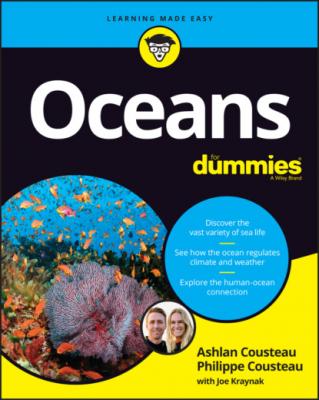Oceans For Dummies. Joseph Kraynak
Читать онлайн.| Название | Oceans For Dummies |
|---|---|
| Автор произведения | Joseph Kraynak |
| Жанр | География |
| Серия | |
| Издательство | География |
| Год выпуска | 0 |
| isbn | 9781119654452 |
Source: Keith Ellenbogen – www.keithellenbogen.com
FIGURE 4-5: Tuna.
Some animals in this zone have evolved the ability to produce their own light — a trait referred to as bioluminescence (creating light through biochemical processes). Instead of carrying a flashlight to find their way in the dark, they are the flashlight. Although scientists aren’t quite sure about the purpose of this superpower, they think it might be used to ward off or evade predators (see the nearby sidebar on counter-illumination), detect or lure prey (ooh, shiny light!), or communicate with members of their own species.
Life starts to get a bit weird in this zone. Here, you’re likely to start bumping into cool fish like the lanternfish, hatchetfish, and barbeled dragonfish, all of which can produce their own light. You can also find species of bristlemouths (it’s okay, I brought my own toothbrush). These fish, generally no larger than your finger, are not only thought to be the most common fish in the ocean, but also the most common vertebrate on Earth — more abundant than humans, chickens, and rats combined. Let that sink in for a second. Some marine mammals and sharks can also be found here, but most will stay in the mesopelagic only for relatively short periods before returning to the surface. Swordfish (see Figure 4-6), ctenophores (see Figure 4-7) and siphonophores (jellyfish relatives), and firefly squid are other interesting animals that can be found in this zone.
Taking a deeper, darker dive into the bathypelagic zone
Just below the mesopelagic zone is the bathypelagic zone (also called the midnight zone), which extends from 1,000 meters to 4,000 meters (3,300 to 13,000+ feet) below sea level. No sunlight penetrates this zone, and the temperature is relatively constant at a very chilly 4 degrees Celsius (39 degrees Fahrenheit). Animals in this zone prey on other bathypelagic organisms or grab whatever organic matter rains down like manna from above. Some creatures in this zone migrate closer to the surface to feed at certain times of day.
Some bioluminescent sea creatures may use this skill as camouflage, illuminating their soft underbellies to blend in with light coming from the surface, while the tops of their bodies remain dark to blend in with the darkness below them. This application of bioluminescence, called counter-illumination, protects the creature from predators above and below. When predators from below look up, all they see is light. When predators from above look down, all they see is darkness. Take that, camo pants.
Joe Fish Flynn/Shutterstock
FIGURE 4-6: Swordfish.
Source: Schmidt Ocean Institute – www.schmidtocean.org
FIGURE 4-7: Ctenophores.
The creatures that live here are too insane to make up, but they’re not the most colorful — just about everything is black or red, which makes them virtually invisible in water at these depths. (Certain wavelengths are filtered by water faster than others. Because red light has the longest wavelength and is absorbed quickest, once you go deep enough, anything red appears black.)
Calling this zone their home are the weird and wonderful barreleye fish, giant isopods, viperfish, vampire squid, and anglerfish. Occasionally you can find sperm whales here, and if you’re really, really lucky, you can see one battling a giant squid (of course if you do, take a picture because no one has captured that epic battle on film yet). The deepest diving marine mammal, the Cuvier’s beaked whale, can also reach this zone. This elusive and strange-looking animal holds the record for the longest mammalian dive, plunging up to 3,500 meters (11,480 feet) deep (that’ll make your ears pop) in search of deep-water cephalopods and squid.
Many animals in this zone and deeper have adaptations to allow them to eat almost anything, including prey much larger than them. Gulper eels have specialized jaw structures that enable them to open their mouths incredibly wide (see Figure 4-8). Sharks and their relatives, including the Greenland shark (which can live for 400 years), ghost shark, frilled shark, and goblin shark can sometimes also be found in this zone, as well as the deepest living octopus, the dumbo octopus shown in Figure 4-9 (although some say it can be found at even greater depths).
Delving into the abyss: The abyssopelagic zone
One step down from the bathypelagic is the abyssopelagic zone (also called the abyss), extending from 4,000 to 6,000 meters (13,000+ to nearly 20,000 feet) below the surface. Imagine totally dark, near-freezing temperatures (though stable), and super high pressure. For animals adapted to these harsh conditions, the pressure is no problem. Unlike animals with gas-filled organs (such as lungs and swim bladders) that would be crushed at these depths, deep-sea creatures are pretty much made up of tissue and fluid. While the high pressure may limit species diversification, it isn’t the hardest part about living here. The more challenging factor is the scarcity of food.
Source: Woods Hole Oceanographic Institution, P. Caiger – www.whoi.edu
FIGURE 4-8: The gulper eel; say ahh!
Source: Schmidt Ocean Institute – www.schmidtocean.org
FIGURE 4-9: Dumbo Octopus; isn’t she (or he) cute?
Generally, the farther down you go, the fewer species you encounter, because these are tough environmental conditions to adapt to. Life here is thought to have changed little over millions of years. Some abyssal species include the common fangtooth, the tripod fish shown in Figure 4-10 (they’re hermaphroditic, meaning they have both male and female reproductive organs, which means they can produce young either with another fish or on their own!), hagfish, cusk eels, grenadiers, and viperfish (Figure 4-11). In some places, you can find deep-sea corals, which don’t need sunlight to survive.
Source: Schmidt Ocean Institute – www.schmidtocean.org
FIGURE 4-10: The tripod fish.
